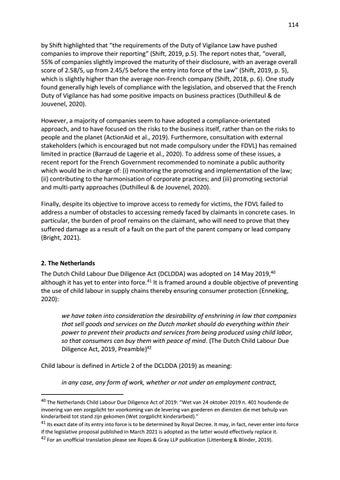114 by Shift highlighted that “the requirements of the Duty of Vigilance Law have pushed companies to improve their reporting” (Shift, 2019, p.5). The report notes that, “overall, 55% of companies slightly improved the maturity of their disclosure, with an average overall score of 2.58/5, up from 2.45/5 before the entry into force of the Law” (Shift, 2019, p. 5), which is slightly higher than the average non-French company (Shift, 2018, p. 6). One study found generally high levels of compliance with the legislation, and observed that the French Duty of Vigilance has had some positive impacts on business practices (Duthilleul & de Jouvenel, 2020). However, a majority of companies seem to have adopted a compliance-orientated approach, and to have focused on the risks to the business itself, rather than on the risks to people and the planet (ActionAid et al., 2019). Furthermore, consultation with external stakeholders (which is encouraged but not made compulsory under the FDVL) has remained limited in practice (Barraud de Lagerie et al., 2020). To address some of these issues, a recent report for the French Government recommended to nominate a public authority which would be in charge of: (i) monitoring the promoting and implementation of the law; (ii) contributing to the harmonisation of corporate practices; and (iii) promoting sectorial and multi-party approaches (Duthilleul & de Jouvenel, 2020). Finally, despite its objective to improve access to remedy for victims, the FDVL failed to address a number of obstacles to accessing remedy faced by claimants in concrete cases. In particular, the burden of proof remains on the claimant, who will need to prove that they suffered damage as a result of a fault on the part of the parent company or lead company (Bright, 2021).
2. The Netherlands The Dutch Child Labour Due Diligence Act (DCLDDA) was adopted on 14 May 2019,40 although it has yet to enter into force.41 It is framed around a double objective of preventing the use of child labour in supply chains thereby ensuring consumer protection (Enneking, 2020): we have taken into consideration the desirability of enshrining in law that companies that sell goods and services on the Dutch market should do everything within their power to prevent their products and services from being produced using child labor, so that consumers can buy them with peace of mind. (The Dutch Child Labour Due Diligence Act, 2019, Preamble)42 Child labour is defined in Article 2 of the DCLDDA (2019) as meaning: in any case, any form of work, whether or not under an employment contract, 40 The Netherlands Child Labour Due Diligence Act of 2019: “Wet van 24 oktober 2019 n. 401 houdende de
invoering van een zorgplicht ter voorkoming van de levering van goederen en diensten die met behulp van kinderarbeid tot stand zijn gekomen (Wet zorgplicht kinderarbeid).” 41 Its exact date of its entry into force is to be determined by Royal Decree. It may, in fact, never enter into force if the legislative proposal published in March 2021 is adopted as the latter would effectively replace it. 42 For an unofficial translation please see Ropes & Gray LLP publication (Littenberg & Blinder, 2019).













